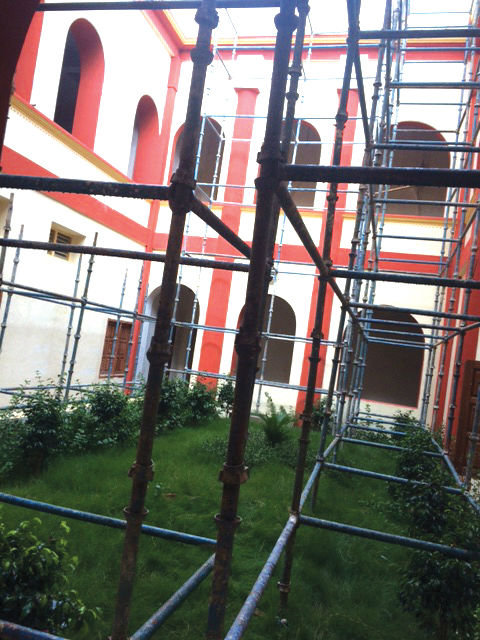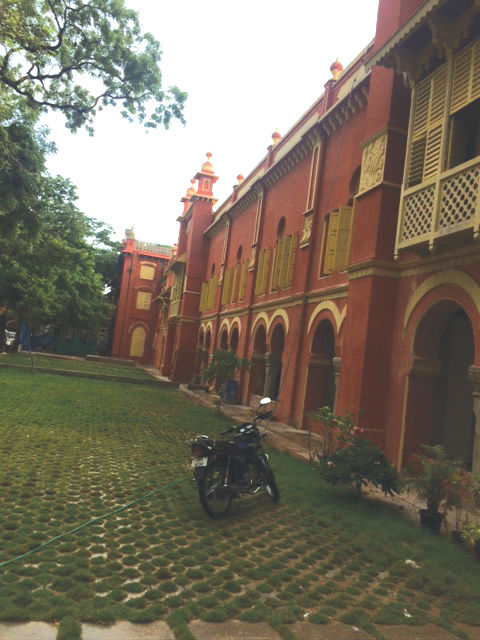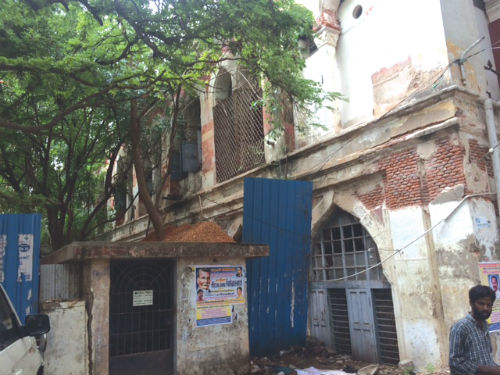Registered with the Registrar of Newspapers for India under R.N.I 53640/91
Vol. XXVII No. 10, September 1-15, 2017
Conservation promised, but where’s the mind-set?

Work still on at Kalas Mahal
It’s good news that the Public Works Department of Tamil Nadu, through its specially formed division, the Building Centre and Conservation Division (BCCD), will be embarking on a major project across the State to conserve heritage buildings that have been in a condition of neglect for several years. It is reported that about 200 such structures have been identified for deeper study of the individual needs of each.
The announcement is a reassurance that the Government is alive to the consequences of continued relegation of conservation to a low priority status. We are assured that the evaluation would be completed in six months. This seems adequate in normal circumstances, but ambitious considering the speed at which public agencies move.
A positive implication of the report also is that the conservation programme is
being viewed, not piece by piece, but in totality. Evaluation of the present condition of heritage structures across the State for their specific requirements has advantages. Monetary and technical requirements can be determined individually and totally to seek one time sanction of money and expertise, saving time. Each heritage site and major components of each site can be prioritised for the urgency that it demands. The more urgent ones can be taken up immediately to beat time and save them from disintegration. Of course, this implies that a certain degree of freedom is given to the BCCD in using the allocated money for any project within the scheme according to priority. In our situation, because of much longer than normal gestation, the money sanctioned at the outset becomes inadequate due to rising costs. Time over-run in execution is translated into cost over-run. This can be taken care of by project management, if given enough freedom within overall limits, to re-direct funds from one project to another, according to the urgency for retrieval.
Allotment of funds is the first pre-requisite for action and the best test of earnestness. There is no indication in the report of the sum sanctioned for this project. To demonstrate earnestness to the public, Government should declare the total sum to be allotted and the sum of the first tranche. Periodic reports of progress placed in public domain would enable activists and public to feel the government working. Pro-active feedback on quality of restoration and undue time-lags would afford scope for timely correctives.

Kalas Mahal – eastern face exterior

Humayun Mahal in total ruin – no evidence of any restoration work having started.
On organisational issues there are concerns. We are told that Public Works Department of Tamil Nadu through its specially formed BCCD would implement the conservation project. It is specially formed to hold exclusive responsibility for this project. Is it also specially trained and equipped in the art and science of handling sensitive heritage structures? The first is necessary but not enough without the second. BCCD should contract a qualified conservation architect with prior experience to guide project execution on scientific norms. “While the BCCD is a good initiative, issues like training PWD engineers in techniques to conserve heritage structures need to be taken care of. Heritage structures demand a different procedure, unlike other buildings. The Department would need the support of conservation architecture firms for a few years,” says A. Srivathsan, Professor of Architecture and Academic Director, Centre for Environmental Planning & Technology, Ahmedabad.
The second organisational concern is this. We are told that BCCD’s restoration work would be carried out under the supervision of the Superintending Engineer (Buildings), Planning and Designs Circle, Chennai and Chief Engineer (Buildings) Chennai Division. As BCCD is meant to be a specially equipped body for restoration work, its specialty work should not be exposed to interference on restoration aspects, by supervising engineers and staff, otherwise well qualified but with no background of handling heritage structures.
Our fears of delays and serious technical inadequacies are not unfounded considering recent experiences. Victoria Public Hall, which is Category 1 heritage structure on which work of conservation was taken up in 2010 with sanction of Rs. 3.39 crore was abandoned before completion when the land was taken over to construct the underground metro. This is a classic example of how not to do heritage conservation work. Kalas Mahal, widely reported in March 2017 as having been restored to its original glory at a cost of Rs. 14.5 crore, is not anywhere near a completed state nor in a state of glory as any visit to the site today would reveal. In the case of Bharat Insurance Company, despite legal pressure upon LIC to institute restoration, it has done nothing, indicating the necessity for more stringent legal enforcement, be it in the case of a public or a private institution.
Announcement of the project and sanction of monies have, in the past, not been a guarantee that conservation projects would be completed successfully and within a reasonable time. Much depends upon things being done with a different mind-set. Let us hope for a pleasant surprise this time.

